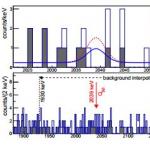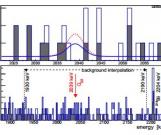Paper of the month: Results on neutrinoless double beta decay of Ge-76 from GERDA Phase I

July 31, 2013 by admin
Deep under the Gran Sasso mountain in Italy, the GERDA experiment is searching for the neutrinoless double beta decay, a process which, if discovered, would prove Majorana's conjecture. In normal beta decay, a neutron inside a nucleus decays into a proton, an electron and an antineutrino. For some nuclei, such as germanium-76, this process is energetically forbidden. However, the simultaneous decay of two neutrons with the emission of two electrons and two antineutrinos is possible and has been measured to have a half-life of about 100 billion times the age of the Universe. If neutrinos are also their own antiparticles, the antineutrino from one beta decay could then be absorbed by a second beta-decaying neutron, thus producing a neutrinoless double beta decay, with an event rate even lower than the previous process.
In GERDA, enriched Ge-76 crystals are used as both sources and detectors. They are immersed in a cryostat filled with liquid argon, which serves as cooling medium and a shield against environmental and cosmic radiation. The background is further reduced by the use of low-radiation materials, a tank of ultra pure water that functions as a Cherenkov light muon veto and the 1400 m of mountain above, providing unprecedented conditions for the search of very rare decays.
The experiment has now completed its first phase with 21 kg years of accumulated data since fall of 2011. A blind analysis has been performed, in which all calibrations and cuts for the processing were defined and the background model was built before revealing the actual data, thus avoiding any means of biasing the results. The unblinding revealed no signal of neutrinoless double beta decay, thus setting the best lower limit for the half-life of the process to 2.1x10^25 years. This result has important implications for the determination of the neutrino masses, sets some constraints to extensions of the Standard Model and provides information for the study of astrophysical processes and cosmology.
The search for the neutrinoless double beta decay will continue with GERDA Phase II, aiming for a sensitivity increased by a factor of 10. Perhaps then the Majorana enigma will finally be solved.
Text by Daniel Mayani
-
Did you know the majority of particles also have a corresponding antiparticle?
Many concepts in the world come with their opposite: good and bad, black and white, up and down, etc. This is true fo...





